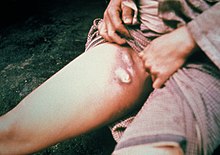 Global Information
Global InformationBubonic plague information
| Bubonic plague | |
|---|---|
 | |
| A bubo on the upper thigh of a person infected with bubonic plague | |
| Specialty | Infectious disease |
| Symptoms | Fever, headaches, vomiting, swollen lymph nodes[1][2] |
| Complications | Gangrene, meningitis[3] |
| Usual onset | 1–7 days after exposure[1] |
| Causes | Yersinia pestis spread by fleas[1] |
| Diagnostic method | Finding the bacterium in the blood, sputum, or lymph nodes[1] |
| Treatment | Antibiotics such as streptomycin, gentamicin, or doxycycline[4][5] |
| Frequency | 650 cases reported a year[1] |
| Deaths | 10% mortality with treatment[4] 30–90% if untreated[1][4] |
Bubonic plague is one of three types of plague caused by the bacterium Yersinia pestis.[1] One to seven days after exposure to the bacteria, flu-like symptoms develop.[1] These symptoms include fever, headaches, and vomiting,[1] as well as swollen and painful lymph nodes occurring in the area closest to where the bacteria entered the skin.[2] Acral necrosis, the dark discoloration of skin, is another symptom. Occasionally, swollen lymph nodes, known as "buboes", may break open.[1]
The three types of plague are the result of the route of infection: bubonic plague, septicemic plague, and pneumonic plague.[1] Bubonic plague is mainly spread by infected fleas from small animals.[1] It may also result from exposure to the body fluids from a dead plague-infected animal.[6] Mammals such as rabbits, hares, and some cat species are susceptible to bubonic plague, and typically die upon contraction.[7] In the bubonic form of plague, the bacteria enter through the skin through a flea bite and travel via the lymphatic vessels to a lymph node, causing it to swell.[1] Diagnosis is made by finding the bacteria in the blood, sputum, or fluid from lymph nodes.[1]
Prevention is through public health measures such as not handling dead animals in areas where plague is common.[8][1] While vaccines against the plague have been developed, the World Health Organization recommends that only high-risk groups, such as certain laboratory personnel and health care workers, get inoculated.[1] Several antibiotics are effective for treatment, including streptomycin, gentamicin, and doxycycline.[4][5]
Without treatment, plague results in the death of 30% to 90% of those infected.[1][4] Death, if it occurs, is typically within 10 days.[9] With treatment, the risk of death is around 10%.[4] Globally between 2010 and 2015 there were 3,248 documented cases, which resulted in 584 deaths.[1] The countries with the greatest number of cases are the Democratic Republic of the Congo, Madagascar, and Peru.[1]
The plague is considered the likely cause of the Black Death that swept through Asia, Europe, and Africa in the 14th century and killed an estimated 50 million people,[1][10] including about 25% to 60% of the European population.[1][11] Because the plague killed so many of the working population, wages rose due to the demand for labor.[11] Some historians see this as a turning point in European economic development.[11] The disease is also considered to have been responsible for the Plague of Justinian, originating in the Eastern Roman Empire in the 6th century CE, as well as the third epidemic, affecting China, Mongolia, and India, originating in the Yunnan Province in 1855.[12] The term bubonic is derived from the Greek word βουβών, meaning "groin."[13]
- ^ a b c d e f g h i j k l m n o p q r s t u World Health Organization (November 2014). "Plague Fact sheet N°267". Archived from the original on 24 April 2015. Retrieved 10 May 2015.
- ^ a b "Plague Symptoms". 13 June 2012. Archived from the original on 19 August 2015. Retrieved 21 August 2015.
- ^ Clinic Bp. "Plague". Mayo Clinic. Retrieved 16 June 2022.
- ^ a b c d e f Prentice MB, Rahalison L (April 2007). "Plague". Lancet. 369 (9568): 1196–1207. doi:10.1016/S0140-6736(07)60566-2. PMID 17416264. S2CID 208790222.
- ^ a b "Plague Resources for Clinicians". 13 June 2012. Archived from the original on 21 August 2015. Retrieved 21 August 2015.
- ^ "Plague Ecology and Transmission". 13 June 2012. Archived from the original on 22 August 2015. Retrieved 21 August 2015.
- ^ Edman BF, Eldridge JD (2004). Medical Entomology a Textbook on Public Health and Veterinary Problems Caused by Arthropods (Rev. ed.). Dordrecht: Springer Netherlands. p. 390. ISBN 978-9400710092.
- ^ McMichael AJ (August 2010). "Paleoclimate and bubonic plague: a forewarning of future risk?". BMC Biology. 8 (1): 108. doi:10.1186/1741-7007-8-108. PMC 2929224. PMID 24576348.
- ^ Keyes DC (2005). Medical response to terrorism : preparedness and clinical practice. Philadelphia [u.a.]: Lippincott Williams & Wilkins. p. 74. ISBN 978-0781749862.
- ^ Haensch S, Bianucci R, Signoli M, Rajerison M, Schultz M, Kacki S, et al. (October 2010). "Distinct clones of Yersinia pestis caused the black death". PLOS Pathogens. 6 (10): e1001134. doi:10.1371/journal.ppat.1001134. PMC 2951374. PMID 20949072.
- ^ a b c "Plague History". 13 June 2012. Archived from the original on 21 August 2015. Retrieved 21 August 2015.
- ^ Cohn SK (2008). "Epidemiology of the Black Death and successive waves of plague". Medical History. Supplement. 52 (27): 74–100. doi:10.1017/S0025727300072100. PMC 2630035. PMID 18575083.
- ^ LeRoux N (2007). Martin Luther As Comforter: Writings on Death Volume 133 of Studies in the History of Christian Traditions. Brill. p. 247. ISBN 978-9004158801.